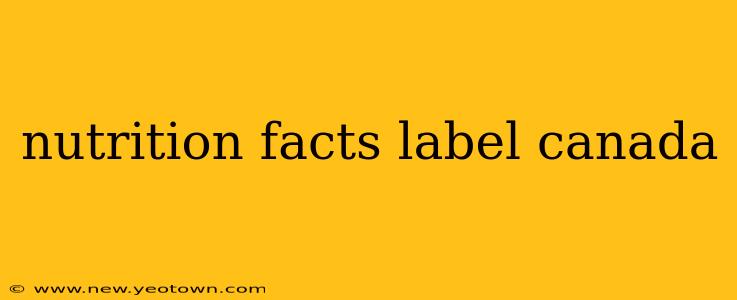Have you ever stared at a Nutrition Facts label, feeling overwhelmed by the numbers and percentages? You're not alone! Many find the Canadian Nutrition Facts label a bit daunting, but understanding its secrets unlocks the power to make informed choices about your food. This isn't just about calories; it's about understanding the components that fuel your body and contribute to your overall health. Let's embark on a journey to decipher this vital piece of information found on almost every packaged food item in Canada.
My own journey began with a simple question: Why do some foods seem healthier than others, even when they have similar calorie counts? The answer, as I discovered, lies within the detailed information presented on the Nutrition Facts label. This isn't just a random collection of numbers; it's a carefully designed system created to help us navigate the world of food choices.
What information is included on the Nutrition Facts label?
The Canadian Nutrition Facts label is a treasure trove of information. It starts with the serving size, a crucial piece of information often overlooked. Many people consume more than one serving, so it’s important to adjust the numbers accordingly. Then, we delve into the calories, a measure of energy provided by the food. Next, we find a breakdown of fat, including saturated and trans fats, often implicated in health concerns. Then, comes the cholesterol, sodium, and carbohydrates, followed by the breakdown of sugars, fibre, and protein. Finally, we see the percentages of the daily value (%DV) for many of these nutrients, providing a useful reference point for how a single serving contributes to your recommended daily intake.
What is the Daily Value (%DV)?
The %DV is perhaps one of the most insightful aspects of the label. It tells you what percentage of your recommended daily intake of a particular nutrient is provided by one serving of the food. For example, a %DV of 10% for vitamin C means that one serving provides 10% of your recommended daily intake of vitamin C. This makes it much easier to compare the nutritional content of different products quickly.
How to understand serving sizes on the Nutrition Facts label?
The serving size is often the most overlooked, yet the most critical aspect of the label. Why? Because all the other values are relative to the serving size. If the serving size is small and you consume multiple servings, you need to multiply the values to get the accurate nutritional breakdown for your actual consumption.
What is the difference between saturated and trans fats?
This is a common question, and it's vital to understand the difference. Saturated fats are generally found in animal products and some plant-based foods, while trans fats are mostly artificially created through a process called hydrogenation. Both are associated with health risks, but trans fats are particularly problematic and should be minimized in your diet. The label will clearly show the amounts of each.
How much sodium should I consume daily?
Sodium intake is a crucial aspect of heart health. The recommended daily sodium intake is generally considered to be less than 2,300 mg, although this can vary depending on individual health conditions and age. The Nutrition Facts label helps you monitor your sodium consumption by clearly stating the amount per serving.
Where can I find more detailed information on the Canadian Nutrition Facts label?
The Government of Canada's website provides comprehensive guidelines and explanations of the Nutrition Facts label, including FAQs and resources to help you interpret the information effectively.
In conclusion, the Canadian Nutrition Facts label is more than just numbers; it's a valuable tool for making informed food choices. By understanding the information it provides and asking clarifying questions, we empower ourselves to make healthier choices and better manage our overall well-being. The journey to understanding your food starts with understanding the label.

